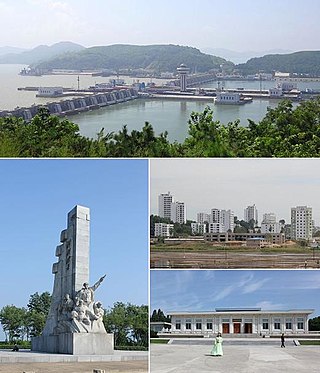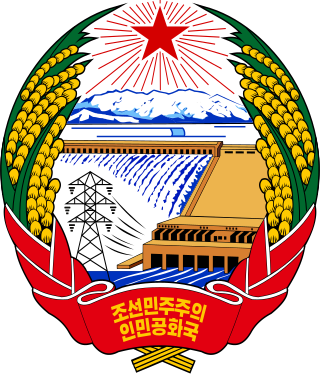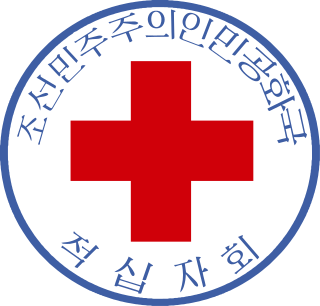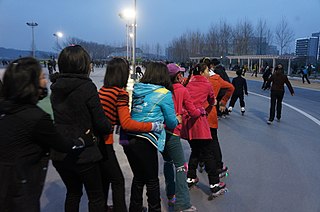
North Korea, officially the Democratic People's Republic of Korea (DPRK), is a country in East Asia. It constitutes the northern half of the Korean Peninsula and borders China and Russia to the north at the Yalu (Amnok) and Tumen rivers, and South Korea to the south at the Korean Demilitarized Zone. The country's western border is formed by the Yellow Sea, while its eastern border is defined by the Sea of Japan. North Korea, like its southern counterpart, claims to be the legitimate government of the entire peninsula and adjacent islands. Pyongyang is the capital and largest city.

Pyongyang is the capital and largest city of North Korea, where it is sometimes labeled as the "Capital of the Revolution". Pyongyang is located on the Taedong River about 109 km (68 mi) upstream from its mouth on the Yellow Sea. According to the 2008 population census, it has a population of 3,255,288. Pyongyang is a directly administered city with a status equal to that of the North Korean provinces.

Kim Jong Il was a North Korean politician who was the second supreme leader of North Korea. He led North Korea from the death of his father Kim Il Sung in 1994 until his own death in 2011, when he was succeeded by his son, Kim Jong Un. Afterwards, Kim Jong Il was declared Eternal General Secretary of the WPK.

The Ryugyong Hotel, or Yu-Kyung Hotel, is an unfinished, topped-out 330-metre-tall (1,080 ft) pyramid-shaped skyscraper in Pyongyang, North Korea. Its name is also one of the historical names for Pyongyang. The building has been planned as a mixed-use development, which would include a hotel.

Nampo, also spelled Namp'o, is the second largest city by population and an important seaport in North Korea, which lies on the northern shore of the Taedong River, 15 km east of the river's mouth. Formerly known as Chinnamp'o, it was a provincial-level "Directly Governed City" ("Chikhalsi") from 1980 to 2004, and was designated a "Special City" in 2010. Nampo is approximately 50 km southwest of Pyongyang, at the mouth of the Taedong River. Since North Korean independence, the city has developed a wide range of industry and has seen significant recent redevelopment.

Education in North Korea is universal and state-funded schooling by the government. As of 2021, UNESCO Institute for Statistics does not report any data for North Korea's literacy rates. Some children go through one year of kindergarten, four years of primary education, six years of secondary education, and then on to university.

Propaganda is widely used and produced by the government of North Korea (DPRK). Most propaganda is based on the Juche ideology and on the promotion of the Workers' Party of Korea.

North Korea has a life expectancy of 72 years as of 2020. While North Korea is classified as a low-income country, the structure of North Korea's causes of death (2013) is unlike that of other low-income countries. Rather, causes of death are closer to the worldwide averages, with non-communicable diseases – such as cardiovascular disease – accounting for two-thirds of the total deaths.
Kwak Pom-gi is a North Korean government official.

The Red Cross Society of the Democratic People's Republic of Korea is the national Red Cross Society of North Korea. It was founded as the Red Cross Society of North Korea on 18 October 1946 by the Soviet-backed occupational government.

The Monument to Party Founding is a monument in Pyongyang, the capital of North Korea.

The Pyongyang Maternity Hospital is a maternity and teaching hospital in Pyongyang. Nurses and midwives are educated in the hospital for work outside the North Korean capital. There is a neonatal intensive care unit at the hospital. In addition, there are multiple different wards, such as dental and breast cancer wards, to treat mothers' various health problems.

Bongsu Church is a Protestant church in the Konguk-dong of the Mangyongdae District of Pyongyang in North Korea.

Pyongyang Skatepark is the first skatepark in North Korea. It was opened in November 2012 and is contained within the Ryugyong Health Complex. The skatepark includes half-pipes, ramps, grind rails and a track.

The Academy of Sciences of the Democratic People's Republic of Korea or State Academy of Sciences, formerly the National Academy of Sciences, is the national academy of sciences of North Korea. It was founded in 1952, and until 1981 was responsible for all research conducted in the country before various organizational reforms and splittings of academies were conducted.
The Ponghwa Clinic and Hospital(봉화진료소) is a hospital located in Sinwŏn-dong, Potonggang-guyok, Pyongyang, North Korea, and is believed to be one of the top hospitals in North Korea, treating members of the political elite. It is administered by the Ministry of Public Health.
The Pyongyang General Hospital is a hospital under construction in Pyongyang, North Korea. The hospital is located in front of Monument to Party Founding. Its groundbreaking took place on 19 March 2020, during the COVID-19 pandemic, and its construction proceeded on the basis of a "speed campaign" with an expected completion date of October 2020, before the 75th anniversary celebrations of the Workers' Party of Korea.














